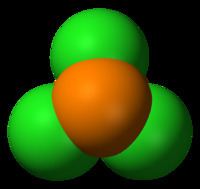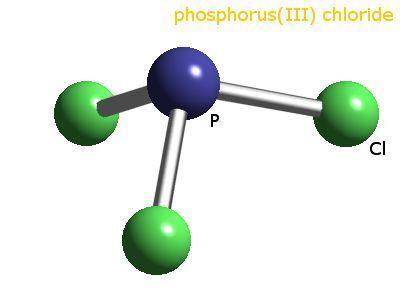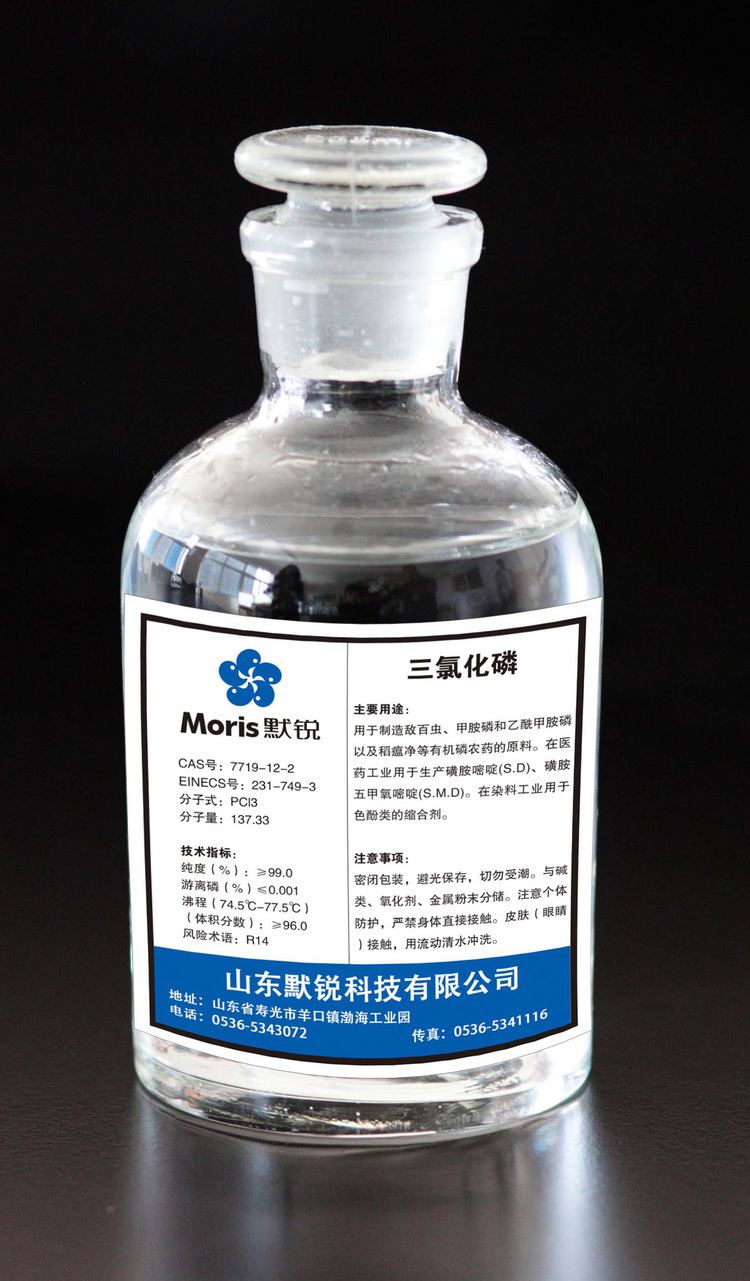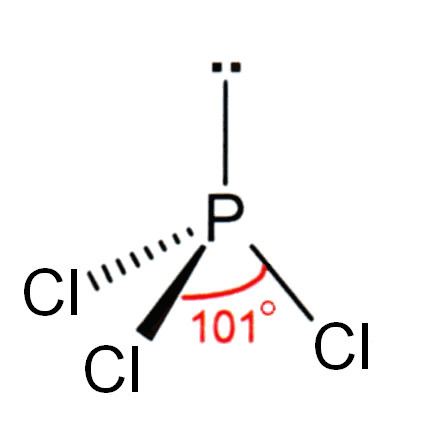Formula PCl3 Molar mass 137.33 g/mol Boiling point 76.1 °C Soluble in Water | IUPAC ID Phosphorus trichloride Density 1.57 g/cm³ Melting point -93.6 °C | |
 | ||
Appearance Colorless to yellow fuming liquid Related phosphorus chlorides Related compounds Thermodynamic
data Phase behaviour
solid–liquid–gas | ||
Pcl3 lewis structure how to draw the lewis structure for pcl3 phosphorus trichloride
Phosphorus trichloride is a chemical compound of phosphorus and chlorine, having the chemical formula PCl3. It has a trigonal pyramidal shape. It is the most important of the three phosphorus chlorides. It is an important industrial chemical, being used for the manufacture of organophosphorus compounds for a wide variety of applications. It has a 31P NMR signal at around +220 ppm with reference to a phosphoric acid standard.
Contents
- Pcl3 lewis structure how to draw the lewis structure for pcl3 phosphorus trichloride
- Phosphorus trichloride
- Chemical properties
- Redox reactions
- PCl3 as an electrophile
- PCl3 as a nucleophile
- Preparation
- Uses
- Precautions
- References

Phosphorus trichloride
Chemical properties

The phosphorus in PCl3 is often considered to have the +3 oxidation state and the chlorine atoms are considered to be in the −1 oxidation state. Most of its reactivity is consistent with this description.
Redox reactions

PCl3 is a precursor to other phosphorus compounds, undergoing oxidation to phosphorus pentachloride (PCl5), thiophosphoryl chloride (PSCl3), or phosphorus oxychloride (POCl3).

If an electric discharge is passed through a mixture of PCl3 vapour and hydrogen gas, a rare chloride of phosphorus is formed, diphosphorus tetrachloride (P2Cl4).
PCl3 as an electrophile

Phosphorus trichloride is the precursor to organophosphorus compounds that contain one or more P(III) atoms, most notably phosphites and phosphonates. These compounds do not usually contain the chlorine atoms found in PCl3.
PCl3 reacts rapidly and exothermically with water to form phosphorous acid, H3PO3 and HCl:
PCl3 + 3 H2O → H3PO3 + 3 HCl
A large number of similar substitution reactions are known, the most important of which is the formation of phosphite esters by reaction with alcohols or phenols. For example, with phenol, triphenyl phosphite is formed:
3 PhOH + PCl3 → P(OPh)3 + 3 HCl
where "Ph" stands for phenyl group, -C6H5. Alcohols such as ethanol react similarly in the presence of a base such as a tertiary amine:
PCl3 + 3 EtOH + 3 R3N → P(OEt)3 + 3 R3NH+Cl−Of the many related compounds can be prepared similarly, triisopropyl phosphite is an example.
In the absence of base, however, the reaction produces phosphonic acid and an alkyl chloride, according to the following stoichiometry:
PCl3 + 3 C2H5OH → 3 C2H5Cl + H3PO3Alternatively, under certain conditions the dialkyl phosphonate (dialkyl phosphite) may be isolated, as well as some alkyl chloride:
PCl3 + 3 iPrOH → (iPrO)2PH=O + iPrCl + 2 HCl(g) where iPr = isopropyl, (CH3)2CH-Amines, R2NH, form P(NR2)3, and thiols (RSH) form P(SR)3. An industrially relevant reaction of PCl3 with amines is phosphonomethylation, which employs formaldehyde:
R2NH + PCl3 + CH2O → (HO)2P(O)CH2NR2 + 3 HClAminophosphonates are widely used as sequestring and antiscale agents in water treatment. The large volume herbicide glyphosate is also produced this way. The reaction of PCl3 with Grignard reagents and organolithium reagents is a useful method for the preparation of organic phosphines with the formula R3P (sometimes called phosphanes) such as triphenylphosphine, Ph3P.
3 PhMgBr + PCl3 → Ph3P + 3 MgBrClUnder controlled conditions PCl3 can be used to prepare PhPCl2 and Ph2PCl.
PCl3 as a nucleophile
Phosphorus trichloride has a lone pair, and therefore can act as a Lewis base, for example with the Lewis acids BBr3 it forms a 1:1 adduct, Br3B−−+PCl3. Metal complexes such as Ni(PCl3)4 are known. This Lewis basicity is exploited in one useful route to organophosphorus compounds using an alkyl chloride and aluminium chloride:
PCl3 + RCl + AlCl3 → RPCl+3 + AlCl−
4
The RPCl+
3 product can then be decomposed with water to produce an alkylphosphonic dichloride RP(=O)Cl2.
Preparation
World production exceeds one-third of a million tonnes. Phosphorus trichloride is prepared industrially by the reaction of chlorine with a refluxing solution of white phosphorus in phosphorus trichloride, with continuous removal of PCl3 as it is formed (in order to avoid the formation of PCl5).
P4 + 6 Cl2 → 4 PCl3Industrial production of phosphorus trichloride is controlled under the Chemical Weapons Convention, where it is listed in schedule 3. In the laboratory it may be more convenient to use the less toxic red phosphorus. It is sufficiently inexpensive that it would not be synthesized for laboratory use.
Uses
PCl3 is important indirectly as a precursor to PCl5, POCl3 and PSCl3, which are used in many applications, including herbicides, insecticides, plasticisers, oil additives, and flame retardants.
For example, oxidation of PCl3 gives POCl3, which is used for the manufacture of triphenyl phosphate and tricresyl phosphate, which find application as flame retardants and plasticisers for PVC. They are also used to make insecticides such as diazinon. Phosphonates include the herbicide glyphosate.
PCl3 is the precursor to triphenylphosphine for the Wittig reaction, and phosphite esters which may be used as industrial intermediates, or used in the Horner-Wadsworth-Emmons reaction, both important methods for making alkenes. It can be used to make trioctylphosphine oxide (TOPO), used as an extraction agent, although TOPO is usually made via the corresponding phosphine.
PCl3 is also used directly as a reagent in organic synthesis. It is used to convert primary and secondary alcohols into alkyl chlorides, or carboxylic acids into acyl chlorides, although thionyl chloride generally gives better yields than PCl3.
Precautions
PCl3 is toxic, with a concentration of 600 ppm being lethal in just a few minutes. PCl3 is classified as very toxic and corrosive under EU Directive 67/548/EEC, and the risk phrases R14, R26/28, R35 and R48/20 are obligatory.
Government agencies in the United States have set occupational exposure limits for PCl3. The Occupational Safety and Health Administration has set a permissible exposure limit at 0.5 ppm over a time-weighted average of 8 hours, while the National Institute for Occupational Safety and Health has set a recommended exposure limit at 0.2 ppm over a time-weighted average of 8 hours. Additionally, PCl3 has been designated IDLH with a maximum exposure limit at 25 ppm.
